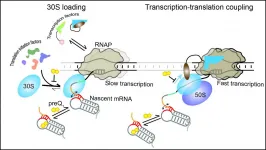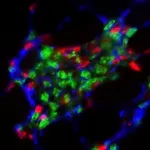(Press-News.org) Most people by now have memorized the public health guidelines meant to help minimize transmission of COVID-19: wash your hands, wear a mask, keep six feet apart from others. That part is easy.
What some may not realize is that upholding these guidelines in certain urban areas can present new challenges.
For example, how are you supposed to stay six feet apart from other people when the standard width of a sidewalk is only four feet? What do you do when you want to cross an intersection that requires pressing a button to activate the pedestrian signal, but you are avoiding touching any surfaces?
The COVID-19 pandemic has drastically altered the way individuals interact with other people and their environment, but some public health guidelines meant to protect people conflict with the way public spaces and transport in urban areas are built.
Drive, bike, or walk? The illusion of choice
Dr. David Rojas, an epidemiologist in the Department of Environmental and Radiological Health Sciences at Colorado State University, works with policy makers to improve urban design to make cities more inclusive and sustainable, resulting in better health outcomes for people.
In the case of COVID-19, he noticed that when urban areas were not optimized to accommodate mitigation strategies, it put some people in the awkward position of compromising certain public health guidelines to make a necessary trip to their place of work, school, or worship. Or fear of coming in contact with COVID-19 and the inability to safely travel outside the home kept other people inside.
"The decisions we make are dictated by the options we have. How we decide to move, for example, like whether we take a car or walk to work," Rojas said.
Choosing to travel by car may result in a shorter commute, but it can also mean less daily physical activity compared to bicycling or walking. Likewise, taking a bicycle on the road may get the muscles moving, but riding alongside vehicles every day increases exposure to air pollution from car exhaust.
"Some people don't have the time or opportunity to consider other options," Rojas said. "They have to take their kids to school and get to work within a short period of time, but public transportation is too slow or there aren't any bus stations nearby."
Try taking a bicycle to work when there aren't clearly marked bike lanes and traffic moves too quickly to ride safely. Or walking where the intersections and sidewalks are too narrow and the pedestrian crossings are dangerous.
The options available differ for everyone depending on a range of contributing factors, and any number of sustained detriments impact health, causing long-term issues like obesity, cardiovascular disease, or diabetes, among others. Even an increase of vehicles on the road raises the risk of traffic accidents, in turn putting pressure on the health care system that is responsible for treating resulting injuries.
Designing urban areas with everyone in mind leads to better health outcomes all the time, not only during a pandemic. But, when COVID-19 hit in 2020, people all over the world slowed down and cities adapted their mobility patterns and use of space. This shift created the perfect environment for Rojas to highlight opportunities for improvement in urban design geared toward improving health.
"We need to think about how people experience public spaces differently," Rojas said. "If we have better sidewalks, better connectivity, larger parks that are better designed for everyone, it will be good for chronic diseases, cancer, and many other relevant health outcomes."
10 interventions for long-term health
In an effort to help communities around the world adapt urban areas in light of COVID-19, Rojas worked with an urban planner to create an infographic that details 10 low-cost, temporary interventions to promote urban improvements and public health. The infographic not only identifies interventions that support COVID-19 mitigation strategies, but also explains that many of the changes can be made permanent to contribute to a long-term health vision.
Some of the interventions include adjusting traffic light timing to favor pedestrians and cyclists, expanding public open spaces, and concentrating freight traffic on main roads and at nighttime to improve traffic safety.
The tactical urbanism interventions as an expansion of short-term COVID-19 mitigation strategies are detailed in an article published in END
How to build a city that prioritizes public health
2021-04-14
ELSE PRESS RELEASES FROM THIS DATE:
RNA holds the reins in bacteria: U-M researchers observe RNA controlling protein synthesis
2021-04-14
To better understand how RNA in bacteria gives rise to protein--and along the way, target these processes in the design of new antibiotics--researchers are turning their attention to the unique way this process happens in bacteria.
In eukaryotic cells, transcription (the process by which information in a DNA strand is copied into messenger RNA) and translation (the process by which a protein is synthesized by the ribosome from the mRNA) are two successive steps. In bacteria, they occur simultaneously: As the RNA is being synthesized by RNA polymerase, the ribosome comes in to make the proteins.
This synchronicity ...
New evidence regarding emerald production in Roman Egypt coming from Wadi Sikait
2021-04-14
"New evidence of the importance of the Roman/Byzantine Mons Smaragdus settlement within the emerald mining network"
A new paper published in the END ...
How to gain a sense of well-being, free and online
2021-04-14
In 2018, when Professor Laurie Santos introduced her course "Psychology and the Good Life," a class on the science of happiness, it became the most popular in the history of Yale, attracting more than 1,200 undergraduate enrollees that first semester. An online course based on those teachings became a global phenomenon. By latest count, 3.38 million people have enrolled to take the free Coursera.org course, called "The Science of Well Being."
But the popularity of the course posed an interesting question. Does taking the course and participating in homework assignments -- which include nurturing social connections, compiling a gratitude list, and meditation -- really help improve a sense of well-being?
The answer is yes, according to two new studies that measured the psychological impact ...
New method measures super-fast, free electron laser pulses
2021-04-14
LOS ALAMOS, N.M., April 14, 2021--New research shows how to measure the super-short bursts of high-frequency light emitted from free electron lasers (FELs). By using the light-induced ionization itself to create a femtosecond optical shutter, the technique encodes the electric field of the FEL pulse in a visible light pulse so that it can be measured with a standard, slow, visible-light camera.
"This work has the potential to lead to a new online diagnostic for FELs, where the exact pulse shape of each light pulse can be determined. That information can help both the end-user and the accelerator scientists," said Pamela Bowlan, Los Alamos National Laboratory's lead researcher on the project. The paper was published April 12, ...
New research provides insight into COVID-19 vaccine reluctancy among social media users
2021-04-14
New research has found that the most reliable indicators of willingness to be vaccinated against SARS-CoV-2, the virus that causes COVID-19, are rejection of conspiracy suspicions about COVID-19 and a positive attitude towards vaccines in general. The study by King's College London and the University of Bristol is published in the leading peer-reviewed journal Psychological Medicine.
The researchers' analysis was based on a large representative sample survey carried out in November-December 2020. They looked at a range of factors that previous ...
Using sound waves to make patterns that never repeat
2021-04-14
Mathematicians and engineers at the University of Utah have teamed up to show how ultrasound waves can organize carbon particles in water into a sort of pattern that never repeats. The results, they say, could result in materials called "quasicrystals" with custom magnetic or electrical properties.
The research is published in Physical Review Letters.
"Quasicrystals are interesting to study because they have properties that crystals do not have," says Fernando Guevara Vasquez, associate professor of mathematics. "They have been shown to be stiffer than similar periodic or disordered materials. They can also conduct electricity, ...
Mediterranean diet with lean beef may lower risk factors for heart disease
2021-04-14
UNIVERSITY PARK, Pa. -- Eating red meat may have a bad reputation for being bad for the heart, but new research found that lean beef may have a place in healthy diets, after all.
In a randomized controlled study, researchers found that a Mediterranean diet combined with small portions of lean beef helped lower risk factors for developing heart disease, such as LDL cholesterol.
Jennifer Fleming, assistant teaching professor of nutrition at Penn State, said the study suggests that healthy diets can include a wide variety of foods, such as red meat, and still be heart friendly.
"When you create a healthy diet built on fruits, vegetables, and other plant-based foods, it leaves room for moderate amounts of other foods like lean beef," Fleming said. "There are still ...
New discovery could lead to therapies for patients with Duchenne muscular dystrophy
2021-04-14
Irvine, CA - April 14, 2021 - A new study, led by the University of California, Irvine (UCI), reveals how chronic inflammation promotes muscle fibrosis, which could inform the development of new therapies for patients suffering from Duchenne muscular dystrophy (DMD), a fatal muscle disease.
Titled, "A Stromal Progenitor and ILC2 Niche Promotes Muscle Eosinophilia and Fibrosis-Associated Gene Expression," the study was published today in Cell Reports.
Chronic inflammation is a major pathological process contributing to the progression and severity of several degenerative disorders, including Duchenne muscular dystrophy (DMD). Studies directed at establishing a causal link between muscular ...
Guide for science outreach
2021-04-14
What are scientists passionate about? What do they actually do, and why does it matter? Answering questions like these is often part of public outreach efforts that, through demystifying the world of science for non-scientists, can increase appreciation for science and boost support for important research initiatives. Outreach can also make the sciences attractive and accessible to a broader diversity of people, who, in turn, can bring new ideas and perspectives.
"Science is having challenges in terms of getting the general public to support it and ...
Diabetes drug shows potential in fighting cancer
2021-04-14
BOSTON - The anti-diabetic drug phenformin may prompt stronger cancer-fighting activities than its sister compound metformin, a finding that could have major implications for current and future clinical trials investigating both agents for their anti-cancer potential, according to researchers at Massachusetts General Hospital (MGH). In a review article in Trends in Cancer, the team presented evidence that immunotherapies such as immune checkpoint inhibitors (which enable T cells to attack and kill cancer cells) in combination with phenformin may also be a promising way to repurpose this diabetic drug as an anti-cancer ...





